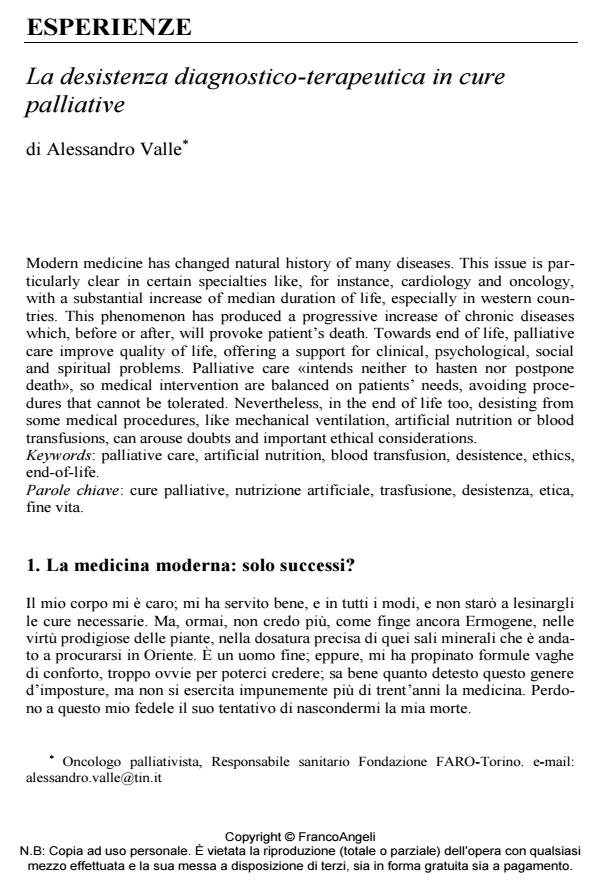La desistenza diagnostico-terapeutica in cure palliative
Journal title SALUTE E SOCIETÀ
Author/s Alessandro Valle
Publishing Year 2015 Issue 2015/3
Language Italian Pages 14 P. 117-130 File size 353 KB
DOI 10.3280/SES2015-003010
DOI is like a bar code for intellectual property: to have more infomation
click here
Below, you can see the article first page
If you want to buy this article in PDF format, you can do it, following the instructions to buy download credits

FrancoAngeli is member of Publishers International Linking Association, Inc (PILA), a not-for-profit association which run the CrossRef service enabling links to and from online scholarly content.
Modern medicine has changed natural history of many diseases. This issue is particularly clear in certain specialties like, for instance, cardiology and oncology, with a substantial increase of median duration of life, especially in western countries. This phenomenon has produced a progressive increase of chronic diseases which, before or after, will provoke patient’s death. Towards end of life, palliative care improve quality of life, offering a support for clinical, psychological, social and spiritual problems. Palliative care «intends neither to hasten nor postpone death», so medical intervention are balanced on patients’ needs, avoiding procedures that cannot be tolerated. Nevertheless, in the end of life too, desisting from some medical procedures, like mechanical ventilation, artificial nutrition or blood transfusions, can arouse doubts and important ethical considerations.
Keywords: Palliative care, artificial nutrition, blood transfusion, desistence, ethics, end-of-life.
- Alsolamy S. (2014). Islamic views on artificial nutrition and hydration in terminally ill patients. Bioethics, 28 (2): 96-9. DOI: 10.1111/j.1467-8519.2012.01996.x40609104819BozzettiF.,ForbesA.(2009).TheESPENclinicalpracticeGuidelinesonParenteralNutrition:presentstatusandperspectivesforfutureresearch.ClinicalNutrition,28(4):359-64.DOI:10.1016/j.clnu.2009.05.01
- Catechismo della Chiesa Cattolica. Parte Terza: la vita in Cristo. Sezione Seconda: i Dieci Comandamenti. Capitolo Secondo: “Amerai il prossimo tuo come te stesso”. Articolo 5: Il Quinto Comandamento. 2278.
- Consiglio Direttivo e Commissione di Bioetica della Società Italiana di Nutrizione Parenterale ed Enterale (2007). Precisazioni in merito alle implicazioni bioetiche della nutrizione artificiale
- Doyle D. (2010). Palliative care in the home: an overview. In: Hanks G., Cherny N.I., Christakis N.A., Fallon M., Kaasa S., Portenoy R.K., Oxford Textbook of Palliative Medicine. Oxford University Press
- Federazione Nazionale degli Ordini dei Medici Chirurghi e degli Odontoiatri (2014). Codice di Deontologia Medica
- Marcoux I., Mishara B.L., Durand C. (2007). Confusion Between Euthanasia and Other End-of-Life Decisions. Influences on Public Opinion Poll Results. Canadian Journal of Public Health. 98 (3): 235-239
- Pontificio Consiglio della Pastorale per gli Operatori Sanitari (1995). Carta degli Operatori Sanitari.
- Presidenza della Repubblica (2010). Legge 15 marzo 2010, n° 38. Disposizioni per garantire l’accesso alle cure palliative e alla terapia del dolore. Gazzetta Ufficiale della Repubblica Italiana, Serie Generale, N° 65. 19 marzo 2010
- Radbruch L., Payne S. (2009). White Paper on standards and norm for hospice and palliative care in Europe: part 1. European Journal of Palliative Care, 16 (6): 278-289
- Scaccabarozzi G., Peruselli C., Lovaglio P., Bellentani M.D., Crippa M., Guglielmi E., a cura di (2013). Accanto al malato oncologico e alla sua famiglia: sviluppare cure domiciliari di buona qualità. Age.Na.S
- Senato della Repubblica (2012). Costituzione della Repubblica Italiana. Roma. Tipografia del Senato
- Smith L.B., Cooling L., Davenport R. (2013). How do I allocate blood products at the end of life? An ethical analysis with suggested guidelines. Transfusion, 53 (4): 696-700. DOI: 10.1111/j.1537-2995.2012.03658.
- Società italiana di Cure Palliative (2012). Il core curriculum in cure palliative. Il core curriculum del medico palliativista. Milano-Roma: Zadig Editore
- Società italiana di Cure Palliative (2013). Il core curriculum in cure palliative. Il core curriculum dell’infermiere in cure palliative. SICP
- Società Italiana di Nutrizione Parenterale ed Enterale (2007). Precisazione in merito alle implicazioni bioetiche della nutrizione artificiale. SINPE Toscani F., Di Giulio P., Brunelli C., Miccinesi G., Laquintana D.; End-of-Life
- Observatory Group. (2005). How people die in hospital general wards: a descriptive study. Journal of Pain and Symptom Management, 30 (1): 33-40
- Turillazzi E., Fineschi V. (2011). Advance directives in therapeutic intervention: a review of the Italian bioethical and juridical debate. Medicine, Science and the Law, 51: 76-80. DOI: 10.1258/msl.2010.01020
- World Health Organization (2002). National Cancer Control Programmes. Policies and managerial guidelines. 2nd Edition. World Health Organization. Geneva
- La famille face à la maladie en phase terminale. Ethnographie dans une maison de soins palliatifs au Piémont (Italie) Alessandro Gusman, in Anthropologie et Santé /2016
DOI: 10.4000/anthropologiesante.2019 - Preparing for a good death? Palliative care representations in the italian public television programming Nicoletta Bosco, Valeria Cappellato, in Death Studies /2022 pp.1963
DOI: 10.1080/07481187.2021.1876788
Alessandro Valle, La desistenza diagnostico-terapeutica in cure palliative in "SALUTE E SOCIETÀ" 3/2015, pp 117-130, DOI: 10.3280/SES2015-003010